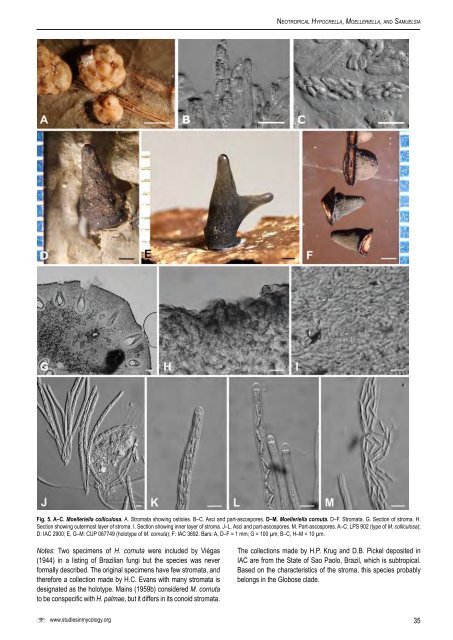Moelleriella, and Samuelsia - CBS
Moelleriella, and Samuelsia - CBS
Moelleriella, and Samuelsia - CBS
- No tags were found...
You also want an ePaper? Increase the reach of your titles
YUMPU automatically turns print PDFs into web optimized ePapers that Google loves.
Ne o t r o p i c a l Hy p o c r e l l a, Mo e l l e r i e l l a, a n d Sa m u e l s i aFig. 5. A–C. <strong>Moelleriella</strong> colliculosa. A. Stromata showing ostioles. B–C. Asci <strong>and</strong> part-ascospores. D–M. <strong>Moelleriella</strong> cornuta. D–F. Stromata. G. Section of stroma. H.Section showing outermost layer of stroma. I. Section showing inner layer of stroma. J–L. Asci <strong>and</strong> part-ascospores. M. Part-ascospores. A–C: LPS 902 (type of M. colliculosa);D: IAC 2900; E, G–M: CUP 067749 (holotype of M. cornuta); F: IAC 3692. Bars: A, D–F = 1 mm; G = 100 µm; B–C, H–M = 10 µm.Notes: Two specimens of H. cornuta were included by Viégas(1944) in a listing of Brazilian fungi but the species was neverformally described. The original specimens have few stromata, <strong>and</strong>therefore a collection made by H.C. Evans with many stromata isdesignated as the holotype. Mains (1959b) considered M. cornutato be conspecific with H. palmae, but it differs in its conoid stromata.The collections made by H.P. Krug <strong>and</strong> D.B. Pickel deposited inIAC are from the State of Sao Paolo, Brazil, which is subtropical.Based on the characteristics of the stroma, this species probablybelongs in the Globose clade.www.studiesinmycology.org35
















